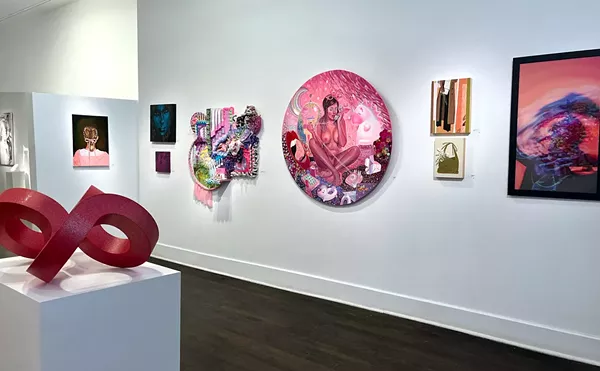
Audio By Carbonatix
[
{
"name": "GPT - Leaderboard - Inline - Content",
"component": "35519556",
"insertPoint": "5th",
"startingPoint": "3",
"requiredCountToDisplay": "3",
"maxInsertions": 100,
"adList": [
{
"adPreset": "LeaderboardInline"
}
]
}
]
Photos are always mysteries: In one, an old man lies on a bed in a small, cramped room, with one foot on the floor and the other, clad in an old-style, cross-country ski boot, resting on the bed. On his head is an old-model headset which is connected to an equally old boom box on the shelf next to the bed. The room has space only for the bed, a stuffed chair, a machine lathe and tools on a workbench above his head.
What is he listening to? The title of the photo is "Utajarvi," which tells us that it is a foreign picture or in a foreign place. The frame harmonizes with the photo. It is old and used-looking. The man is completely involved in what he is doing. He looks comfortable, without strife, and oblivious to our presence.
On the crowded wall above the bed are five clocks of different styles -- three contemporary, two historic. One clock is made from a horse collar. All of them say that it is 7:47. The light in the room doesn't indicate whether it is a.m. or p.m. Nothing tells us, but it compels us to ask. Is the man listening to music in the early evening or the news in the early morning? Is it folk music or a Sibelius symphony (the photographer is Finnish and "Utajarvi" sounds very Finnish)?
There are also a couple of photos and landscape pictures on the wall above him. There is a wall telephone within his reach. The picture is a complete question. It offers no conclusive information that would tell us the man's story, though we could easily construct one from the accoutrements in the room.
The photo is by Esko Männikkö, a Finnish photographer who is one of nine photographers in the current Cranbrook Art Museum exhibition entitled "Evidence: Photography and Site." The 11 photos by Männikkö in the show are all ambiguous compositions that position the viewer before some benign but pleasurable abyss of information that is unsolvable and leads us back to thinking about photography itself as the subject of his art.
The best of the nine photographers in the exhibit make pictures that read, like "Utajarvi," as mysteries. It would be convenient to write off Männikkö's works as simply a collection of homey photos which thus achieve the status of ethnographic data.
At the other extreme, Uta Barth's three large, ethereal photos, which might remind us of English painter J.M.W. Turner's complex 19th-century paintings, have an immediate surprise in their apparently complete lack of subject. We are confronted by a wall of unfocused, tinted photographic emulsion containing only a few suggestions of structure, of being somewhere. Upon scrutiny, a plane in the photo is noticeably in focus. In the catalog, we are informed that Barth's technique was to compose a photograph with shallow depth of field and then to remove the subject upon which she had focused, creating this curious image of absence.
"Evidence" was organized by the prestigious Wexner Center for the Arts in Columbus, Ohio, and one of the curators' essays in the catalog explains that each of the photographers records "the interaction between the body and the static artifacts of architecture and space" or, as another curator has phrased it, "constructed space." There are no manipulated or doctored photos in the exhibition, so what we realize through these keen cameras is the complex relationship between ourselves and the space we inhabit. The photos themselves are merely evidence or, in the best cases, texts that record and elucidate the peculiar relationships we have with the built space around us.
Among the diverse collection of photographs in the show are: the cityscapes of Lorna Simpson, well known for her images of African-American women; Margaret Morton's documents of the life of the "homeless" in their New York City underworld habitations; Hiroshi Sugimoto's gorgeous explorations of empty movie houses and drive-in theaters; Stephen Barker and Merry Alpern's voyeuristic tours of the underworld spaces of drug and sexual encounters; Lynne Cohen's layered institutional spaces; and Thomas Struth's explorations of the sometimes ideologically composed, sometimes anarchic social spaces we inhabit.
"Evidence" is an exhibition that makes its way into new and uncharted relationships of contemporary consciousness and art, and demands of its viewers a deliberate focus on the structure of the everyday world.
E-mail comments to letters@metrotimes.com




